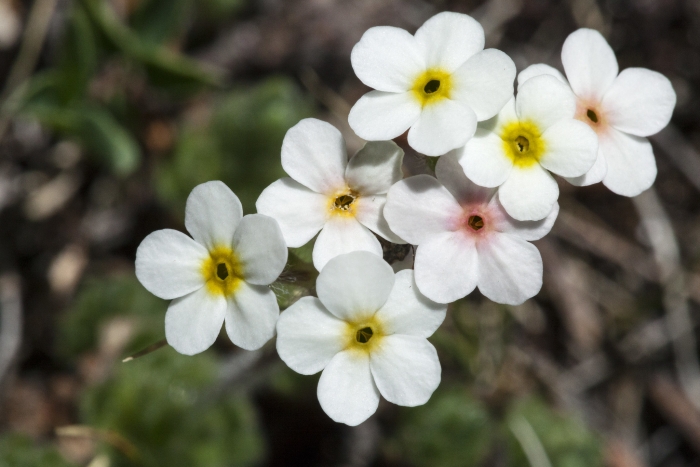Sweetflower Rockjasmine
(Androsace chamaejasme)
Sweetflower Rockjasmine (Androsace chamaejasme)
/
/

Patrick Alexander
CC0
Image By:
Patrick Alexander
Recorded By:
Copyright:
CC0
Copyright Notice:
Photo by: Patrick Alexander | License Type: CC0 | License URL: https://creativecommons.org/licenses/by-sa/4.0 | Uploader: Josve05a | Publisher: Wikimedia Commons |




























Estimated Native Range
Summary
Androsace chamaejasme, commonly known as Sweetflower Rockjasmine, is an evergreen perennial herb native to alpine and subalpine zones, scree slopes, and rocky areas in Central Asia, the Himalayas, and parts of Europe. It typically forms low-growing mats reaching a height of 0.2 feet (0.06 meters) and spreading up to 0.5 feet (0.2 meters). The plant has small rosettes of leaves and produces clusters of white, sometimes pink-tinged flowers with a yellow eye, blooming in late spring to early summer. The flowers are quite showy relative to the plant’s size and attract pollinators.
Sweetflower Rockjasmine is valued for its delicate floral display and its ability to thrive in rock gardens, alpine troughs, and as a ground cover in well-drained areas. It is also suitable for crevice planting in walls or steps. This species requires well-drained, gritty soil and tolerates a range of light conditions from full sun to part shade. It is relatively low maintenance but benefits from protection against excessive winter wetness. While generally disease-free, it can suffer from root rot if overwatered or planted in poorly drained soils. It is not known for being invasive and is often used in cultivation for its ornamental appeal and adaptability to challenging garden sites.CC BY-SA 4.0
Sweetflower Rockjasmine is valued for its delicate floral display and its ability to thrive in rock gardens, alpine troughs, and as a ground cover in well-drained areas. It is also suitable for crevice planting in walls or steps. This species requires well-drained, gritty soil and tolerates a range of light conditions from full sun to part shade. It is relatively low maintenance but benefits from protection against excessive winter wetness. While generally disease-free, it can suffer from root rot if overwatered or planted in poorly drained soils. It is not known for being invasive and is often used in cultivation for its ornamental appeal and adaptability to challenging garden sites.CC BY-SA 4.0
Plant Description
- Plant Type: Herb
- Height: 0.1-0.2 feet
- Width: 0.25-0.5 feet
- Growth Rate: Slow
- Flower Color: White
- Flowering Season: Spring, Summer
- Leaf Retention: Evergreen
Growth Requirements
- Sun: Full Sun, Part Shade
- Water: Medium
- Drainage: Fast
Common Uses
Low Maintenance, Potted Plant, Rock Garden
Natural Habitat
Native to alpine and subalpine zones, scree slopes, and rocky areas in Central Asia, the Himalayas, and parts of Europe
Other Names
Common Names: Bewimperter Mannsschild
Scientific Names: , Androsace chamaejasme, Androsace longiscapa, Douglasia johnstonii, Gregoria johnstonii, Primula chamaejasme var. typica,
GBIF Accepted Name: Androsace chamaejasme Wulfen